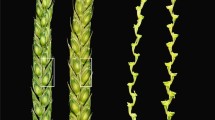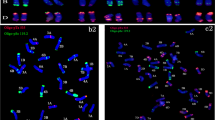Abstract
The gene pool of Aegilops tauschii, the D-genome donor of common wheat (Triticum aestivum L.), can be easily accessed in wheat breeding, but remains largely unexplored. In our previous studies, many synthetic hexaploid wheat lines were produced through interspecific crosses between the tetraploid wheat cultivar Langdon and various A. tauschii accessions. The synthetic hexaploid wheat lines showed wide variation in many characteristics. To elucidate the genetic basis of variation in flowering-related traits, we analyzed quantitative trait loci (QTL) affecting time to heading, flowering and maturity, and the grain-filling period using four different F2 populations of synthetic hexaploid wheat lines. In total, 10 QTLs located on six D-genome chromosomes (all except 4D) were detected for the analyzed traits. The QTL on 1DL controlling heading time appeared to correspond to a flowering time QTL, previously considered to be an ortholog of Eps-A m 1 which is related to the narrow-sense earliness in einkorn wheat. The 5D QTL for heading time might be a novel locus associated with wheat flowering, while the 2DS QTL appears to be an allelic variant of the photoperiod response locus Ppd-D1. Some of the identified QTLs seemed to be novel loci regulating wheat flowering and maturation, including a QTL controlling the grain filling period on chromosome 3D. The exercise demonstrates that synthetic wheat lines can be useful for the identification of new, agriculturally important loci that can be transferred to, and used for the modification of flowering and grain maturation in hexaploid wheat.


Similar content being viewed by others
References
Beales J, Turner A, Griffiths S, Snape JW, Laurie DA (2007) A pseudo-response regulator is misexpressed in the photoperiod insensitive Ppd-D1a mutant of wheat (Triticum aestivum L.). Theor Appl Genet 115:721–733
Bullrich L, Appendino ML, Tranquilli G (2002) Mapping of a thermo-sensitive earliness per se gene on Triticum monococcum chromosome 1Am. Theor Appl Genet 105:585–593
Cockram J, Jones H, Leigh FJ, O’Sullivan D, Powell W, Laurie DA, Greenland AJ (2007) Control of flowering time in temperate cereals: genes, domestication, and sustainable productivity. J Exp Bot 58:1231–1244
Dvorak J, Luo MC, Yang ZL, Zhang HB (1998) The structure of the Aegilops tauschii gene pool and the evolution of hexaploid wheat. Theor Appl Genet 97:657–670
Egawa C, Kobayashi F, Ishibashi M, Nakamura T, Nakamura C, Takumi S (2006) Differential regulation of transcript accumulation and alternative splicing of a DREB2 homolog under abiotic stress conditions in common wheat. Genes Genet Syst 81:77–91
Faricelli ME, Valárik M, Dubcovsky J (2010) Control of flowering time and spike development in cereals: the earliness per se Eps-1 region in wheat, rice, and Brachypodium. Funct Integr Genomics 10:293–306
Faure S, Turner AS, Gruszka D, Christodoulou V, Davis SJ, von Korff M, Laurie DA (2012) Mutation at the circadian clock gene EARLY MATURITY 8 adapts domesticated barley (Hordeum vulgare) to short growing seasons. Proc Natl Acad Sci USA 109:8328–8333
Feldman M (2001) Origin of cultivated wheat. In: Bonjean AP, Angus WJ (eds) The world wheat book: a history of wheat breeding. Lavoisier, Paris, pp 3–53
Fu D, Dunbar M, Dubcovsky J (2007) Wheat VIN3-like PHD finger genes are up-regulated by vernalization. Mol Genet Genomics 277:301–313
Fujiwara Y, Shimada S, Takumi S, Murai K (2010) Differential effects of Aegilops tauschii genotypes on maturing-time in synthetic hexaploid wheats. Breed Sci 60:286–292
Gororo NN, Flood RG, Eastwood RF, Eagles HA (2001) Photoperiod and vernalization responses in Triticum turgidum × T. tauschii synthetic hexaploid wheats. Ann Bot 88:947–952
Guo Z, Song Y, Zhou R, Ren Z, Jia J (2010) Discovery, evaluation and distribution of haplotypes of the wheat Ppd-D1 gene. New Phytol 185:841–851
Hanocq E, Niarquin M, Heumez E, Rousset M, Le Gouis J (2004) Detection and mapping of QTL for earliness components in a bread wheat recombinant inbred lines population. Theor Appl Genet 110:106–115
Hori K, Kobayashi T, Shimizu A, Sato K, Kawasaki S (2003) Efficient construction of high-density linkage map and its application to QTL analysis in barley. Theor Appl Genet 107:806–813
Huang L, Wang Q, Zhang LQ, Yuan ZW, Wang JR, Zhang HG, Zheng YL, Liu DC (2012) Haplotype variations of gene Ppd-D1 in Aegilops tauschii and their implications on wheat origin. Genet Resour Crop Evol 59:1027–1032
Iehisa JCM, Shimizu A, Sato K, Nasuda S, Takumi S (2012) Discovery of high-confidence SNPs from large-scale de novo analysis of leaf transcripts of Aegilops tauschii, a wild wheat progenitor. DNA Res 19:487–497
Kajimura T, Murai K, Takumi S (2011) Distinct genetic regulation of flowering time and grain-filling period based on empirical study of D-genome diversity in synthetic hexaploid wheat lines. Breed Sci 61:130–141
Kato K, Yokoyama M (1992) Geographical variation in heading characters among wheat landraces, Triticum aestivum L., and its implication for their adaptability. Theor Appl Genet 84:259–265
Kerber ER (1987) Resistance to leaf rust in hexaploid wheat: Lr32, a third gene derived from Triticum tauschii. Crop Sci 27:204–206
Kobayashi F, Takumi S, Handa H (2010) Identification of quantitative trait loci for ABA responsiveness at the seedling stage associated with ABA-regulated gene expression in common wheat. Theor Appl Genet 121:629–641
Kosambi DD (1944) The estimation of map distance from recombination values. Ann Eugen 12:172–175
Koyama K, Hatano H, Nakamura J, Takumi S (2012) Characterization of three VERNALIZATION INSENSITIVE3-like (VIL) homologs in wild wheat, Aegilops tauschii Coss. Hereditas 149:62–71
Lander ES, Green P, Abrahamson J, Barlow A, Daly MJ, Lincoln SE, Newburg L (1987) An interactive computer package for constructing primary genetic linkage maps of experimental and natural populations. Genomics 1:174–181
Law CN, Worland AJ (1997) Genetic analysis of some flowering time and adaptive traits in wheat. New Phytol 137:19–28
Law CN, Sutka J, Worland AJ (1978) A genetic study of day length response in wheat. Heredity 41:185–191
Lin F, Xue SL, Tian DG, Li CJ, Cao Y, Zhang ZZ, Zhang CQ, Ma ZQ (2008) Mapping chromosomal regions affecting flowering time in a spring wheat RIL population. Euphytica 164:769–777
Ma H, Singh P, Mujeeb-Kazi A (1995) Resistance to stripe rust in Triticum turgidum, T. tauschii and their synthetic hexaploids. Euphytica 82:117–124
Matsuoka Y, Nasuda S (2004) Durum wheat as a candidate for the unknown female progenitor of bread wheat: an empirical study with a highly fertile F1 hybrid with Aegilops tauschii Coss. Theor Appl Genet 109:1710–1717
Matsuoka Y, Takumi S, Kawahara T (2008) Flowering time diversification and dispersal in central Eurasian wild wheat Aegilops tauschii Coss.: genealogical and ecological framework. PLoS ONE 3:e3138
Mayer KFX, Martis M, Hedley PE, Simková H, Liu H, Morris JA, Steuernagel B, Taudien S, Roessner S, Gundlach H, Kubaláková M, Suchánková P, Murat F, Felder M, Nussbaumer T, Graner A, Salse J, Endo T, Sakai H, Tanaka T, Itoh T, Sato K, Platzer M, Matsumoto T, Scholz U, Dolezel J, Waugh R, Stein N (2011) Unlocking the barley genome by chromosomal and comparative genomics. Plant Cell 23:1249–1263
Mizuno N, Yamasaki M, Matsuoka Y, Kawahara T, Takumi S (2010a) Population structure of wild wheat D-genome progenitor Aegilops tauschii Coss.: implications for intraspecific lineage diversification and evolution of common wheat. Mol Ecol 19:999–1013
Mizuno N, Hosogi N, Park P, Takumi S (2010b) Hypersensitive response-like reaction is associated with hybrid necrosis in interspecific crosses between tetraploid wheat and Aegilops tauschii Coss. PLoS ONE 5:e11326
Mujeeb-Kazi A, Rosas V, Roldan S (1996) Conservation of the genetic variation of Triticum tauschii (Coss.) Schmalh. (Aegilops squarrosa auct. non L.) in synthetic hexaploid wheats (T. turgidum L. s.lat. × T. tauschii; 2n = 6× = 42, AABBDD) and its potential utilization for wheat improvement. Genet Resour Crop Evol 43:129–134
Murai K, Ikari C, Shitsukawa N (2005) Pathways that promote the floral transition in wheat. In: Tsunewaki K (ed) Frontiers of wheat bioscience. Memorial Issue of Wheat Information Service, Kihara Memorial Foundation, Yokohama, pp 119–128
Scarth R, Law CN (1983) The location of the photoperiod gene, Ppd2, and an additional genetic factor for ear-emergence time on chromosome 2B of wheat. Heredity 51:607–619
Snape JW, Quarrie SA, Laurie DA (1996) Comparative mapping and its use for the genetic analysis of agronomic characters in wheat. Euphytica 89:27–31
Snape JW, Butterworth K, Whitechurch E, Worland AJ (2001) Waiting for fine times: genetics of flowering time in wheat. Euphytica 119:185–190
Somers DJ, Isaac P, Edwards K (2004) A high density microsatellite consensus map for wheat (Triticum aestivum L.). Theor Appl Genet 109:1105–1114
Takumi S, Nishioka E, Morihiro H, Kawahara T, Matsuoka Y (2009a) Natural variation of morphological traits in wild wheat progenitor Aegilops tauschii Coss. Breed Sci 59:579–588
Takumi S, Naka Y, Morihiro H, Matsuoka Y (2009b) Expression of morphological and flowering time variation through allopolyploidization: an empirical study with 27 wheat synthetics and their parental Aegilops tauschii accessions. Plant Breed 128:585–590
Torada A, Michiya K, Keiichi M (2006) SSR-based linkage map with new markers using an intraspecific population of common wheat. Theor Appl Genet 112:1042–1051
Tsunewaki K (1966) Comparative gene analysis of common wheat and its ancestral species. II. Waxiness, growth habit and awnedness. J Jpn Bot 19:175–229
Uauy C, Brevis JC, Dubcovsky J (2006) The high grain protein content gene Gpc-B1 accelerates senescence and has pleiotropic effects on protein content in wheat. J Exp Bot 57:2785–2794
Wang S, Carver B, Yan L (2009) Genetic loci in the photoperiod pathway interactively modulate reproductive development of winter wheat. Theor Appl Genet 118:1339–1349
Wang S, Basten CJ, Zeng ZB (2011) Windows QTL cartographer 2.5. Department of Statics, North Carolina State University, Raleigh. http://statgen.ncsu.edu/qtlcart/WQTLCart.htm
Xiang ZG, Zhang LQ, Ning SZ, Zheng YL, Liu DC (2008) Evaluation of Aegilops tauschii for heading date and its gene location in a re-synthesized hexaploid wheat. Agric Sci China 8:1–7
Xu X, Bai G, Carver BF, Shaner GE (2005) A QTL for early heading in wheat cultivar Suwon 92. Euphytica 146:233–237
Yoshida T, Nishida H, Zhu J, Nitcher R, Distelfeld A, Akashi Y, Kato K, Dubcovsky J (2010) Vrn-D4 is a vernalization gene located on the centromeric region of chromosome 5D in hexaploid wheat. Theor Appl Genet 120:543–552
Acknowledgments
This work was financially supported by the Ministry of Agriculture, Forestry and Fisheries, Japan through a research project entitled “Development of technologies for mitigation and adaptation to climate change” in Agriculture, Forestry and Fisheries. This work was also partly supported by a grant from the Ministry of Education, Culture, Sports, Science and Technology of Japan (Grant-in-Aid for Scientific Research (B) No. 21380005).
Author information
Authors and Affiliations
Corresponding author
Rights and permissions
About this article
Cite this article
Nguyen, A.T., Iehisa, J.C.M., Kajimura, T. et al. Identification of quantitative trait loci for flowering-related traits in the D genome of synthetic hexaploid wheat lines. Euphytica 192, 401–412 (2013). https://doi.org/10.1007/s10681-013-0873-7
Received:
Accepted:
Published:
Issue Date:
DOI: https://doi.org/10.1007/s10681-013-0873-7




